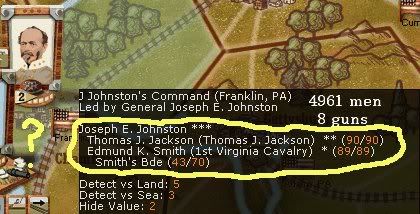The designers have truly implemented some fine levels of nuance in the tooltip intelligence levels provided you.

The necessity for cavalry to get up close and personal to refine your knowledge begets an interesting cat and mouse game since cavalry provides refined information (at a cost if it gets detected). But I digress.

Please notice these nuances: An enemy division strength unit will have its lead brigade annotated in parenthesis when your intelligence level is high enough. A divisionless leader is simply listed. Now you can count the number of constructed divisions present.
So hence, if that level of intel is available to you, you can tell the number of divisions in the command and that can provide your numbers.
The power number if provided, will tell you if the division(s) are either understrength (not full 18 elements) or tired (low cohesion--tired from marching or fighting). You get to decide based on past events/context. As has been stated a full strength division is in the 480-600 power range. Less than that, they are depleted and require reinforcements or rest.
When I observed Banks and Soundoffs AARs while the numbers gave it a very authentic and tactical flavor, I wanted to know, in context, the power from those numbers since they would tell me....tired or fresh, effective or non effective. That's where power listings can help you a bunch. BTW, my hats off to those two for providing the community such a thorough presentation and commitment. I learned alot. Thanks you two!
Another intelligence nuance that can be glossed over (that drastically affects frontages, which are the key to winning tactical battles): the type of command in an opposting stack. A three star is not necessarily an Army commander. He could be a corps or an independent command. But the tooltip will often tell you. This has GREAT impact on determining your upcoming turn tactics. If your opponent has not made Grant an army commander, he can't pass down those awesome add on stats to his subordinates and hence they could be vulnerable in woods and clear terrain. If he is, he could show up marching to the sound of the guns and take them away replacing his (good) stats for possibly higher ones. Interesting possiblities!
If a two star is not a corps commander the same principle applies that his command points are weak and penalties (sometimes listed) will effect those who get in the next fight.
Conversely one wily opponent I had, used my intelligence against me. He came up with a "hidden leader" for the next attack from a lower sized stack in the same region that I could not see. Neat move!
Familiarity with the icon pictures is also a plus. When you get no intel, sometimes recognizing the opposing commander is helpful.
Ah, I digress again. Forgive me. Your original question was how to determine numbers from power. Can't be done effectively. Power numbers, as has been said, can be a gauge of effectiveness or size. But your question regarding size is important too because if tired, when rested, those troops can become strong. And to keep them unrested can be a viable of your grand tactics.
Like Patton, if you keep the enemy always moving, they can't rest unless withdrawn. How many divisions are present is my idea as a key.
You can determine the number of divisions or division equivalents usually pretty accurately and from that, you can get a pretty close guesstimate of the numbers of infantry and artillery as has already been described. When I put my guesstimates up against the actual count showing on battle results, my intell has proven itself very accurate.
For me, the key to winning battles is how many artillery units I can get into contact, at far range, WITH FIRST FIRE. Corps artillery helps there.Leadership and unit initiative help too. And number of divisions helps me determine enemy infantry and artillery capabilities. My intel involves divisons, size of division, terrain, frontages, enemy composition and initiative capabilities of the units and commanders. But I would be hijacking this thread to take it further. AACW provides a fascinating world of intelligence benefit as to enemy capabilities!
Suffice it to say, I disagree with the commonly held belief on this forum that defense is king and that the road to victory is to get the opposition to attack me. While that can work, it leaves the initiative to the enemy. Major Tom has provided a wealth of information regarding frontage and ZOC possiblities there. Thanks to him too for excellent research! But that's a whole 'nother story.
Good luck with your armies, your numbers and your intelligence!


 Its an engine limitation. Because of divisions are formed of various brigades and units the game cannot calculate the total maximum power.
Its an engine limitation. Because of divisions are formed of various brigades and units the game cannot calculate the total maximum power.


 The necessity for cavalry to get up close and personal to refine your knowledge begets an interesting cat and mouse game since cavalry provides refined information (at a cost if it gets detected). But I digress.
The necessity for cavalry to get up close and personal to refine your knowledge begets an interesting cat and mouse game since cavalry provides refined information (at a cost if it gets detected). But I digress.